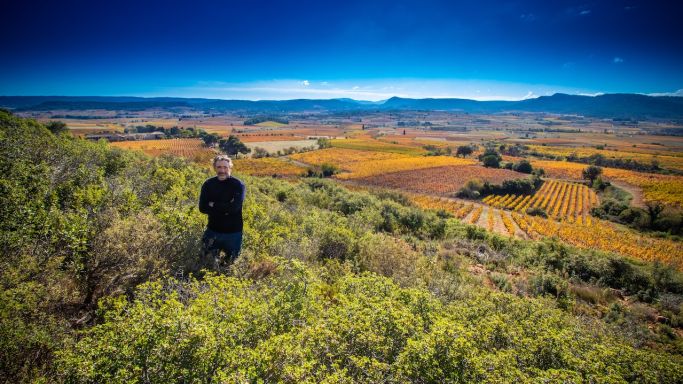These Languedoc rosés pack in more value than any Provence pinks we’ve tasted this year. Above, Pierre Bories, the man responsible for them. Starting at €11.50, $13, £10.95.
Château Ollieux Romanis is a 60-hectare (148-acre) domaine in the Boutenac area of the Corbières that has belonged to the Bories family since 1978 (although its history as a wine estate dates back to the 18th century). Pierre Bories, who up until then had worked in finance, came ‘home’ in 2001 because his parents had been badly let down by an exporter and, through no fault of their own, the property was in real financial difficulty. He took the estate over, ‘with no clients and a lot of debt’, and over the last two decades has radically transformed it.
Starting with a team of just three people, including himself, he began to restore vineyards and invest. He reunited Ollieux Romanis with its neighbouring property, Château Les Ollieux (the two properties had been divided between two sisters in 1872). He converted the whole property to organic farming (certified), planted hundreds of trees and hedges to build and restore biodiversity, and deployed a flock of organically reared sheep to graze the vineyards in winter. He’s also overseen the establishment of extensive kitchen gardens, growing vegetables, fruit and herbs which now supply the estate’s restaurant and staff (he now employs a team of nearly 50).
Like all of his properties (Bories also owns Domaine Pierre Bories, Domaine Le Champ des Murailles and, most recently, Château Rives-Blanques), Ollieux Romanis is currently in conversion to biodynamic certification. They’ve planted féverole (horse beans) between vines to increase nitrogen in the soil, and other cover crops with deep, widespread rooting systems to prevent compaction and improve drainage and water retention. And they’re running trials with Carignan Noir and Blanc, Cinsault, Grenache and Assyrtiko to measure and monitor the impact of pergola training on ground shade and soil temperature, soil health, leaf surface area and shading of fruit bunches on alcohol and acidity. Bories tells me, ‘We have two parcels, both organically farmed, one traditionally trellised and one in pergola-style, so we can compare the results.’ They recently built a new, eco-friendly winery. And they’re conserving their old vineyards, one of which is listed in our Old Vine Registry.
All of which brings me to his two rosés. Having recently tasted some spectacularly dull Provence rosés at pretty eye-watering prices (no names mentioned, but there might be a celebrity or two involved), it was a pinch-me moment to come across two rosés that are better than the average Provence pinks at super-super-GV (good-value) prices. Not only are these wines unbelievably affordable (especially from The Wine Society in the UK), but they’re grown and made with real integrity. These are genuine terroir wines but made without fuss or pretension. They’re both clean, classic and elegant, although the Cuvée Classique is more exuberantly fruity than the more restrained and mineral Alba. Both wines are certified organic and tuck in at just 12.5% alcohol.
My tasting notes are below.
Château Ollieux Romanis, Cuvée Classique Rosé 2023 Corbières
Certified organic (Ecocert). 40% Cinsault, 40% Grenache Noir, 20% Grenache Gris. Vines 10–50 years old on red Mediterranean sandstone, rolled pebbles and limestone. Skin maceration for three to six hours, cool fermentation. Aged in stainless-steel tanks.
Frankly delicious! A festival of orchard fruit so fresh that it tastes as if it’s only just been picked off the trees. Nectarines and apples and oranges with a zap of lime peel. A new-summer-morning kind of wine, glistening with the brightest of sunlit dew. This is a pour-me-another-please wine – if I ran a restaurant (any restaurant) this would be my house rosé, by the glass and bottle. VGV (TC)
The Wine Society sells this for a mere £10.95, but you can also get it from Joseph Barnes Wines and Les Caves de Pyrene for £14.80, and Wine & Greene in Totnes for £15. It’s imported into the US by Monterey Bay Wine Company (CA) and Elliot Bay (WA) and sells, I’m told, for around $13. It’s also available in the Netherlands and Switzerland.
Château Ollieux Romanis, Alba Rosé 2023 Corbières
Certified organic (Ecocert). 80% Grenache Gris, 10% Grenache Noir, 10% Cinsault. Vines from 20 to 70 years old on Boutenac terroir (red sandstone). Fermented in stainless steel.
Like their Classique Rosé, this has tremendous purity and abundance of fruit, although this is a little less exuberant. It has a fine spine of minerality that tastes like chalk and wet steel, and traces of dried thyme and sage on the end. Oranges, especially on the finish. Graceful. VGV (TC)
The Wine Society also sells this, once again for a crazily low price – £13.95 (a Provence wine of this calibre would probably set you back £25 at least). It is imported into the US by Monterey Bay Wine Company (CA) and you can also find it in Switzerland and Denmark.
Whether you’re doing summer on a budget or love a really high-quality rosé, you could not do better than these two wines. And if you’re a member of The Wine Society, stock up! These are the best-value rosés I’ve ever come across.
The photos are all supplied by Château Ollieux Romanis and the main photo of Pierre Bories in the Ollieux Romanis Corbières vineyards is copyright Céline Deschamps.
For more rosés, of every shade of pink and style and from every region imaginable, see our tasting notes database.





